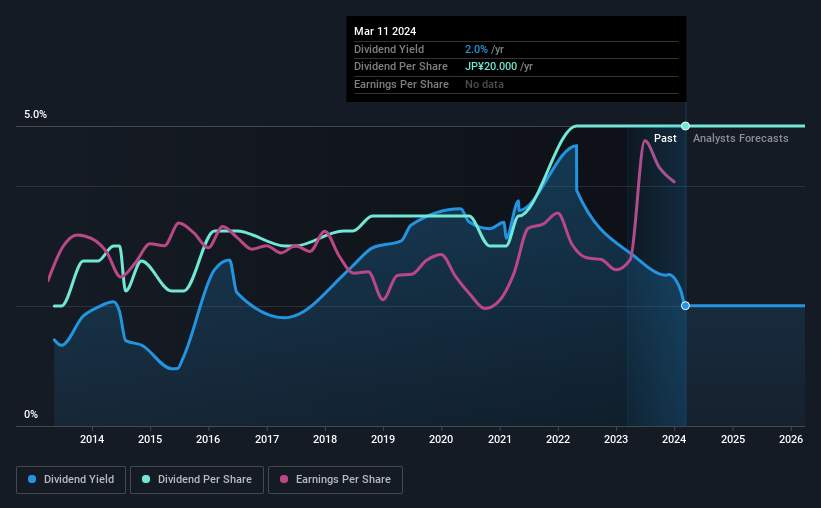
The Hachijuni Bank, Ltd. (TSE:8359) has announced that it will pay a dividend of ¥10.00 per share on the 26th of June. Including this payment, the dividend yield on the stock will be 2.0%, which is a modest boost for shareholders' returns.
Check out our latest analysis for Hachijuni Bank
Hachijuni Bank's Earnings Will Easily Cover The Distributions
The dividend yield is a little bit low, but sustainability of the payments is also an important part of evaluating an income stock.
Hachijuni Bank has a long history of paying out dividends, with its current track record at a minimum of 10 years. Based on Hachijuni Bank's last earnings report, the payout ratio is at a decent 27%, meaning that the company is able to pay out its dividend with a bit of room to spare.
EPS is set to fall by 24.2% over the next 12 months. But if the dividend continues along recent trends, we estimate the future payout ratio could be 38%, which we would consider to be quite comfortable looking forward, with most of the company's earnings left over to grow the business in the future.

Dividend Volatility
While the company has been paying a dividend for a long time, it has cut the dividend at least once in the last 10 years. The dividend has gone from an annual total of ¥8.00 in 2014 to the most recent total annual payment of ¥20.00. This works out to be a compound annual growth rate (CAGR) of approximately 9.6% a year over that time. We have seen cuts in the past, so while the growth looks promising we would be a little bit cautious about its track record.
The Dividend Looks Likely To Grow
With a relatively unstable dividend, it's even more important to see if earnings per share is growing. We are encouraged to see that Hachijuni Bank has grown earnings per share at 14% per year over the past five years. With a decent amount of growth and a low payout ratio, we think this bodes well for Hachijuni Bank's prospects of growing its dividend payments in the future.
We Really Like Hachijuni Bank's Dividend
Overall, we like to see the dividend staying consistent, and we think Hachijuni Bank might even raise payments in the future. The distributions are easily covered by earnings, and there is plenty of cash being generated as well. However, it is worth noting that the earnings are expected to fall over the next year, which may not change the long term outlook, but could affect the dividend payment in the next 12 months. All in all, this checks a lot of the boxes we look for when choosing an income stock.
Companies possessing a stable dividend policy will likely enjoy greater investor interest than those suffering from a more inconsistent approach. At the same time, there are other factors our readers should be conscious of before pouring capital into a stock. To that end, Hachijuni Bank has 3 warning signs (and 1 which is a bit concerning) we think you should know about. If you are a dividend investor, you might also want to look at our curated list of high yield dividend stocks.
Valuation is complex, but we're here to simplify it.
Discover if Hachijuni Bank might be undervalued or overvalued with our detailed analysis, featuring fair value estimates, potential risks, dividends, insider trades, and its financial condition.
Access Free AnalysisHave feedback on this article? Concerned about the content? Get in touch with us directly. Alternatively, email editorial-team (at) simplywallst.com.
This article by Simply Wall St is general in nature. We provide commentary based on historical data and analyst forecasts only using an unbiased methodology and our articles are not intended to be financial advice. It does not constitute a recommendation to buy or sell any stock, and does not take account of your objectives, or your financial situation. We aim to bring you long-term focused analysis driven by fundamental data. Note that our analysis may not factor in the latest price-sensitive company announcements or qualitative material. Simply Wall St has no position in any stocks mentioned.
About TSE:8359
Hachijuni Bank
Provides various banking products and services to individuals, corporations, and sole proprietors.
Proven track record with adequate balance sheet.
Similar Companies
Market Insights
Community Narratives



